A 15-item wardrobe for four seasons is designed to maximize versatility and minimize clutter by choosing high-quality, timeless pieces that can be layered and mixed easily. Focus on neutral colors, fabrics suited for various climates, and essential items like tops, bottoms, and outerwear. By combining these strategically, you create a functional, sustainable wardrobe that adapts to changing weather and styles. Explore further to discover how to build this efficient, evidence-backed closet.
Key Takeaways
- A 15-item wardrobe can effectively cover all four seasons by selecting versatile, high-quality pieces that layer well.
- Focus on neutral, timeless essentials like tops, bottoms, and outerwear to maximize mix-and-match options year-round.
- Incorporate climate-appropriate fabrics such as Merino wool, linen, and thermo-regulating materials for comfort across seasons.
- Strategic pattern mixing and cohesive color schemes enhance outfit variety without exceeding the item limit.
- Regular curation and sustainable choices ensure longevity, reduce waste, and maintain a minimalist, eco-friendly wardrobe.
Understanding the Principles of Minimalist Wardrobe Planning

To build a minimalist wardrobe effectively, you need to understand its core principles. Focus on quality over quantity by investing in durable, high-quality pieces that last longer. Choose versatile items that can be mixed and matched to create multiple outfits, making your wardrobe more functional. Prioritize sustainability by selecting clothing made from long-lasting fabrics, reducing waste and environmental impact. Reflect your personal style through curated choices, eliminating unnecessary items that don’t align with your taste. Efficiency is key—limiting your options helps reduce decision fatigue and simplifies daily dressing. Understanding the importance of cohesive wardrobe planning can enhance the overall longevity and utility of your collection. Recognizing how personality traits influence your clothing choices can lead to more satisfying style decisions. These principles guide you in creating a streamlined wardrobe that’s stylish, sustainable, and tailored to your needs, setting a solid foundation for a functional four-season capsule.
Key Benefits of a Four-Season Capsule Wardrobe

A four-season capsule wardrobe makes choosing outfits easier and faster, so you can start your day with confidence. It helps cut down on clutter and spending by focusing on versatile, quality pieces you love to wear. Plus, it offers the flexibility to adapt your style throughout the year without overstuffing your closet. Simplifies wardrobe management, allowing you to spend less time on clothing decisions and more on what truly matters. Incorporating climate adaptability ensures your wardrobe remains functional and stylish across all seasons.
Simplifies Wardrobe Choices
Having a four-season capsule wardrobe makes daily outfit choices much simpler and less stressful. It reduces decision fatigue by limiting choices to versatile, complementary pieces, making it easier to pick outfits quickly. With fewer options, you spend less time agonizing over matching clothes, allowing for faster dressing routines. This simplicity boosts your confidence and mental clarity, as you stick to a consistent style that suits your preferences. Preparing outfits becomes more efficient, freeing up minutes each morning and preventing unnecessary delays. Additionally, a streamlined wardrobe minimizes the overwhelm caused by clutter, helping you focus on what truly matters. Overall, this approach makes dressing effortless, saving you time and reducing daily stress around wardrobe decisions. A capsule wardrobe’s focus on timeless, versatile pieces also helps ensure your wardrobe remains sustainable and adaptable across seasons.
Cuts Clutter and Costs
By limiting your clothing choices to a well-curated capsule wardrobe, you naturally reduce physical clutter and create a more organized living space. With fewer items, your closet becomes easier to maintain, making it simple to find what you need quickly. This streamlined approach also saves time by eliminating endless searching and decision-making. Additionally, a smaller wardrobe encourages you to focus on essential, versatile pieces, which can lead to a clearer sense of personal style. It promotes sustainability by reducing waste and discouraging fast fashion, and it supports higher-quality, longer-lasting clothes. Economically, you spend less on impulse buys and unnecessary items, while investing in durable pieces. Overall, a capsule wardrobe minimizes clutter and cuts costs, making your daily routine more efficient and eco-friendly. Research shows that the global market for sustainable fashion is projected to reach USD 7.8 billion by 2031, reflecting a growing consumer shift toward environmentally conscious choices.
Ensures Year-Round Flexibility
A four-season capsule wardrobe guarantees year-round flexibility by offering a curated selection of pieces that adapt seamlessly to changing weather conditions. You can mix and match lightweight fabrics for spring and summer with layered, insulated items for fall and winter. This setup enables quick adjustments to sudden weather shifts while maintaining style coherence. Seasonal rotation ensures you only keep weather-appropriate clothing accessible, reducing clutter and storage needs. Outerwear and footwear are chosen for functionality across seasons, enhancing comfort and versatility. Additionally, designing a capsule with seasonal adaptability in mind allows for effortless styling transitions and ensures your wardrobe remains relevant throughout the year. Incorporating weather-appropriate clothing pieces enhances the wardrobe’s flexibility and usefulness across all seasons. Here’s a visual to clarify:
| Season | Key Clothing Items | Accessories |
|---|---|---|
| Spring/Summer | Light fabrics, bright colors | Scarves, jewelry |
| Autumn/Winter | Layered, insulated pieces, boots | Belts, hats |
| Year-Round | Versatile essentials for layering | Sunglasses, scarves |
Determining the Optimal Number of Pieces for Versatility
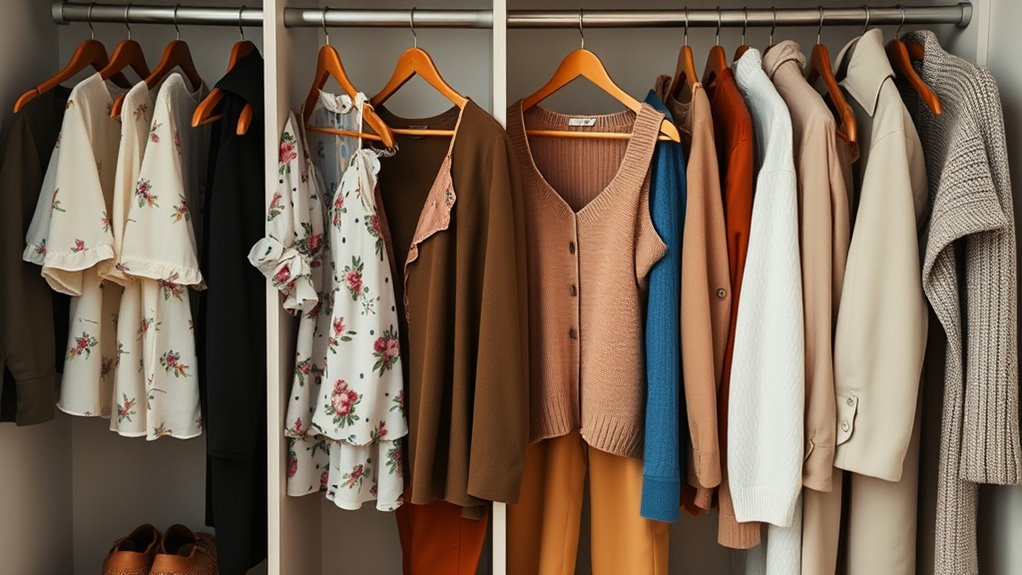
Choosing the right number of pieces for your wardrobe is essential to maximize versatility without creating clutter. Studies suggest around 30–40 versatile items strike the perfect balance, covering various seasons and occasions. Focus on quality over quantity, selecting timeless, easily mixable garments. A neutral color palette and classic cuts boost compatibility across different outfits and weather conditions. To help guide your choices, consider:
- Limiting your wardrobe to 30–40 carefully selected pieces.
- Prioritizing multi-functional items that can serve multiple purposes.
- Including layering pieces like sweaters and jackets to adapt to seasonal changes.
- Unplanned weather changes can lead to comical wardrobe adjustments, so incorporating adaptable clothing is beneficial.
- The optimal wardrobe size varies depending on individual lifestyle needs and preferences to ensure both practicality and style flexibility.
Selecting Core Clothing Modules for Year-Round Use
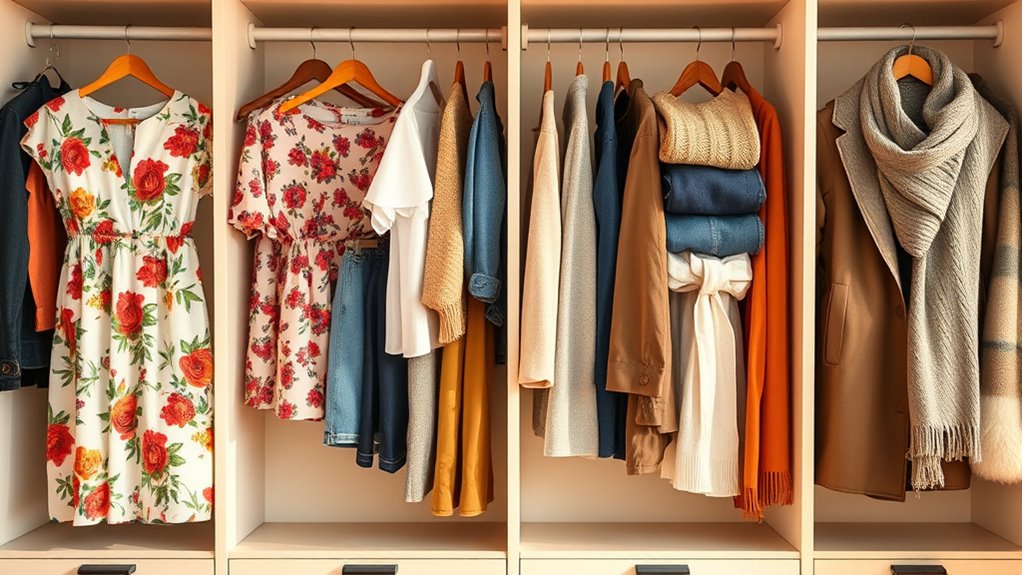
Choosing versatile basics and layers is key to creating a wardrobe that works year-round. You’ll want pieces that can be easily mixed, matched, and adapted for changing temperatures. Including transitional items guarantees your wardrobe stays functional and stylish through every season. Investing in quality fabrics and timeless cuts ensures longevity and versatility across different weather conditions. Moreover, cultivating creative practice in selecting and styling your wardrobe can lead to innovative ways to combine pieces and adapt to new trends.
Versatile Basics and Layers
To build a versatile year-round wardrobe, focus on selecting foundational pieces that can be layered and adapted across all seasons. These basics should be timeless, durable, and easy to mix and match, supporting many outfits with fewer items. Prioritize neutral colors and classic cuts that won’t go out of style, making layering seamless. The goal is to maximize outfit options while minimizing clutter and waste. All Year Capsule Wardrobe Basics also emphasizes the importance of quality over quantity, ensuring each piece lasts through multiple seasons and reduces the need for frequent replacements. Consider these core items: 1. Jeans and versatile pants for casual to polished looks 2. Neutral blouses and tops for layering and variety 3. Sweaters and cardigans for warmth and style flexibility. Incorporating layering techniques can further extend the usability of these pieces, adapting to fluctuating temperatures and changing occasions effortlessly.
Seasonal Transition Pieces
Seasonal shift pieces are essential for creating a flexible wardrobe that adapts smoothly to changing weather. During spring and fall, demand for lightweight layers like cardigans and light jackets peaks, helping you adjust to fluctuating temperatures. Accessories such as scarves and versatile footwear also see increased popularity, offering quick styling updates. Fabrics matter: breathable cotton and linen suit summer, while wool and cashmere work well for autumn and winter. Mid-weight blends like cotton-wool provide adaptability during progressions. Functional designs—zip-off sleeves, removable linings, neutral colors—enhance versatility, ensuring your clothing can handle variable weather. These pieces support a streamlined wardrobe, allowing you to layer effectively and reduce seasonal clutter, all while maintaining style and comfort year-round. Incorporating layering techniques can further optimize your wardrobe’s adaptability across seasons.
Prioritizing Fabric Choices for Climate Adaptability
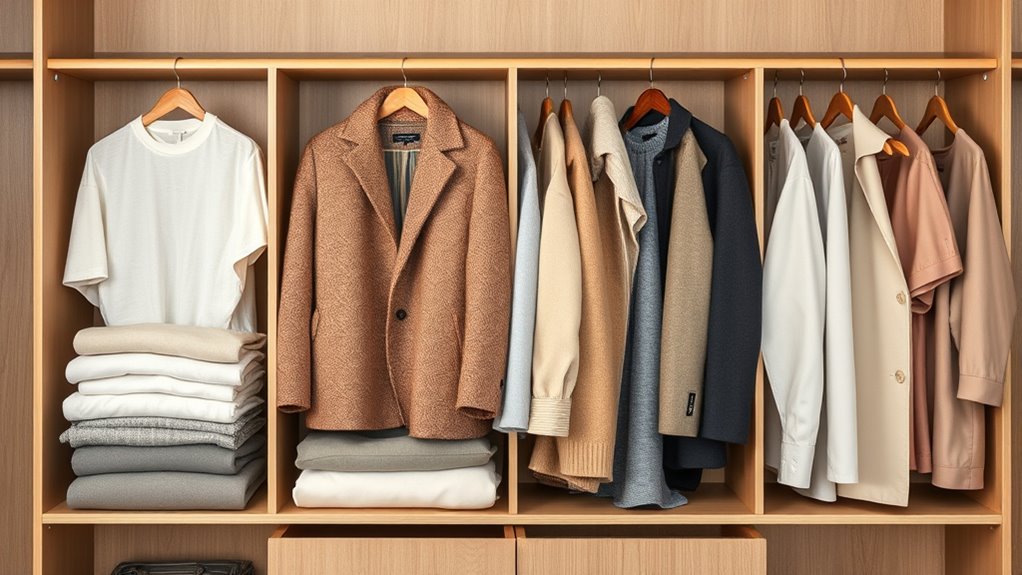
Prioritizing fabric choices for climate adaptability involves selecting materials that respond dynamically to temperature fluctuations and moisture levels. You want fabrics that keep you comfortable year-round, whether it’s hot or cold.
Consider these options:
- Thermo-regulating fabrics like phase change materials (PCM) absorb and release heat, adapting to your environment.
- Bast fibers such as linen and hemp, with hollow structures, wick moisture quickly and cool or insulate as needed.
- Protein-based fibers like lightweight Merino wool, which absorb moisture and trap heat without overheating.
Choosing these fabrics ensures your wardrobe adjusts seamlessly to changing weather, keeping you comfortable no matter the season. They optimize thermal regulation and moisture management for versatile, climate-adaptive dressing.
Color Schemes and Pattern Mixing for Maximal Flexibility
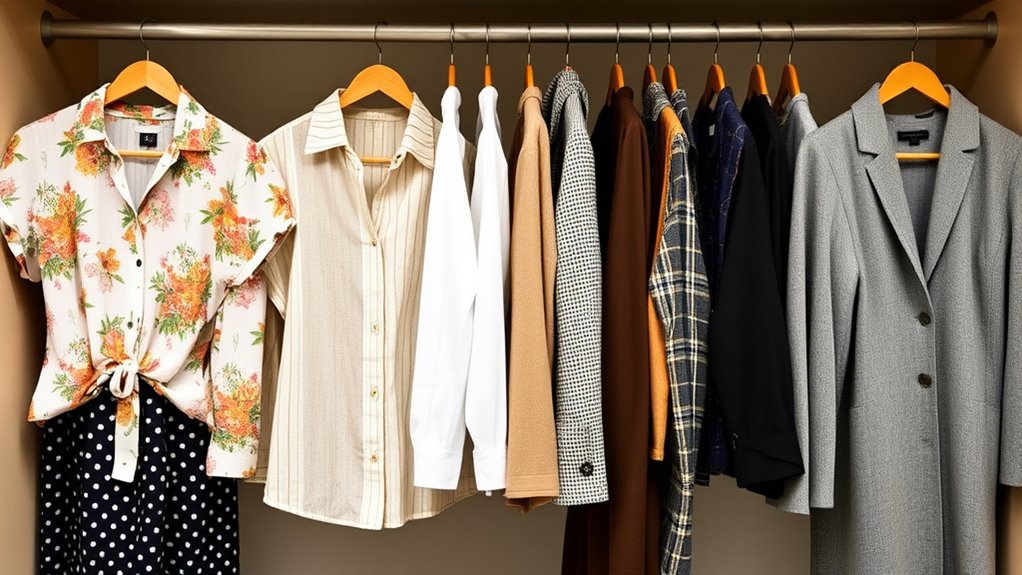
You can maximize your wardrobe’s flexibility by harmonizing base tones that work across seasons. Mixing patterns strategically—pairing contrasting prints or balancing textures—adds visual interest without clashing. By thoughtfully combining colors and patterns, you create versatile outfits suitable for any occasion or weather. Color analysis plays a key role in selecting harmonious combinations, ensuring that your choices complement your natural features and seasonal characteristics. Incorporating dynamic communication exercises can also enhance your ability to confidently mix and match styles through better understanding and expression.
Harmonizing Base Tones
Harmonizing base tones is essential for creating versatile and cohesive wardrobe options that work across different seasons. When you choose the right color schemes, you can mix and match effortlessly, ensuring your outfits stay fresh year-round. Colors are interactions on the color wheel, not just individual shades. Consider these approaches: 1. Use analogous color schemes by selecting colors next to each other on the color wheel for harmonious looks. 2. Opt for monochromatic schemes, playing with various shades and tints of a single color for a sleek, sophisticated appearance. 3. Incorporate triadic color schemes with three equally spaced colors, adding vibrancy and balance to your wardrobe. Additionally, understanding color interactions can help prevent clashing and promote visual harmony in your outfits.
Mixing Patterns Strategically
Mixing patterns adds vibrant interest and flexibility to your wardrobe, but doing so successfully requires strategic choices. Start with solids to anchor your look, offering versatility across seasons and formal to casual settings. Use a limited number of patterns—preferably two or three—to keep outfits manageable. Combine different pattern sizes, like small florals with larger stripes, for visual harmony. Choose patterns with shared colors or neutral bases to create cohesion. Incorporate geometric patterns first, then add florals with subtle prints for variety. Limit accessories and focus on texture interplay for depth. Remember, confidence is key—practice makes perfect. Additionally, understanding pattern proportion helps in balancing different prints effectively.
Building a Foundation With Timeless and Neutral Items
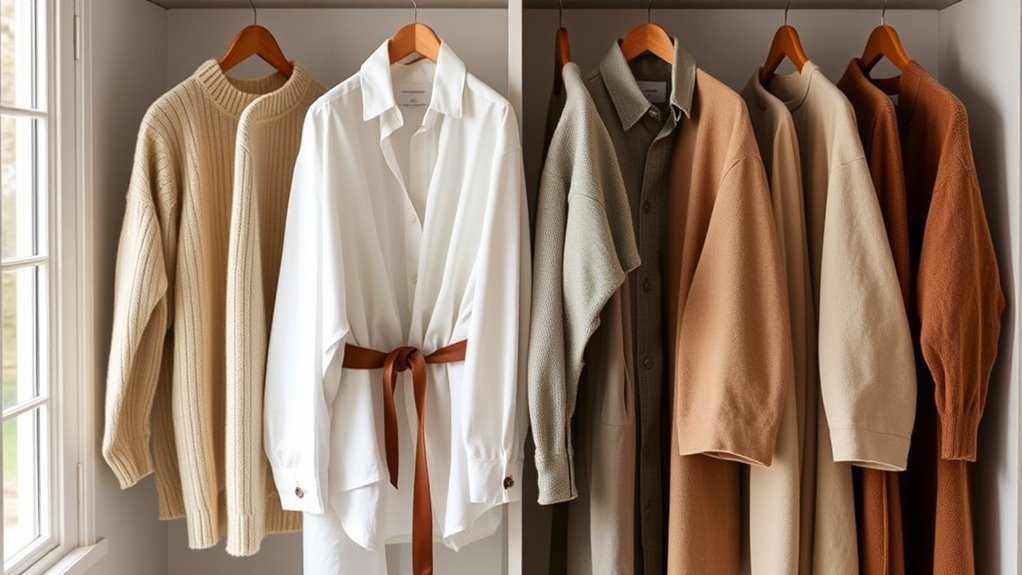
Building a solid wardrobe foundation starts with selecting timeless and neutral pieces that can seamlessly adapt to any season. These essentials create versatility and guarantee your wardrobe stays relevant year-round. Focus on high-quality items in classic shades like black, navy, gray, or earthy tones inspired by nature, as they effortlessly mix and match with other pieces. Incorporating trendy styles in small doses can keep your wardrobe fresh without sacrificing timelessness. Consider these key items: 1. A crisp white shirt made from cotton or linen, perfect for both casual and formal occasions. 2. Tailored trousers in neutral shades that work across seasons and settings. 3. A classic wool coat that provides warmth and style during cooler months. Choosing durable fabrics and minimalist silhouettes helps you build a timeless, sustainable wardrobe that withstands changing trends.
Incorporating Seasonal Pieces Without Overloading
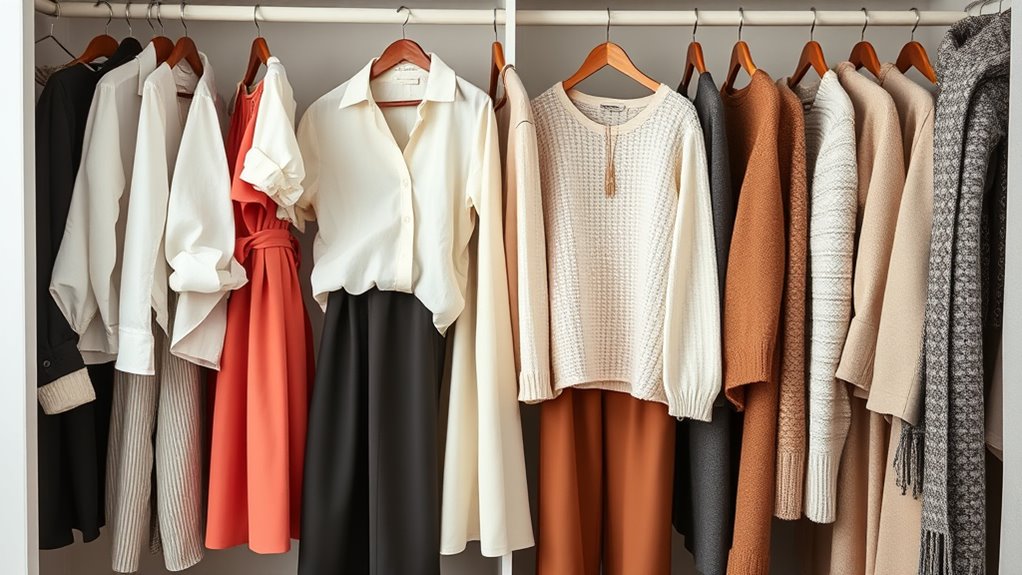
Incorporating seasonal pieces into your wardrobe doesn’t mean you have to overload on new items; instead, focus on selecting versatile, trend-inspired pieces that enhance your existing basics. Opt for lightweight cardigans, blazers, or transitional outerwear in pastel hues or floral prints to reflect spring and summer trends without cluttering your closet. Prioritize pieces made from sustainable materials and lightweight fabrics like cotton and linen, which are perfect for layering across seasons. These adaptable items can be styled for work or casual outings, especially as layering remains a key fashion trend. By choosing quality, multi-use pieces, you maintain a streamlined wardrobe while staying current with seasonal colors and styles. This approach guarantees you look fresh without sacrificing simplicity or versatility. Additionally, sustainable fabrics like organic cotton or linen are increasingly popular among eco-conscious shoppers, ensuring your wardrobe choices align with current consumer priorities.
Strategies for Outfit Repetition and Personal Uniforms
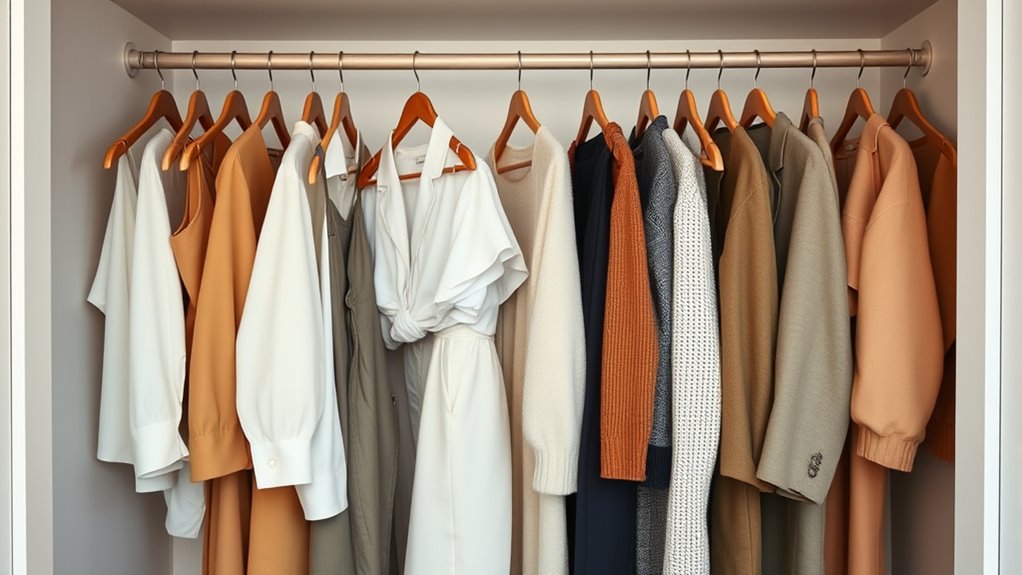
Adopting a personal uniform or strategic outfit repetition can simplify your wardrobe and boost your confidence. It reduces decision fatigue, saves time, and reinforces your professional identity. Plus, wearing a consistent look can foster psychological benefits like increased confidence and a sense of belonging. To implement this effectively, consider these strategies:
- Choose versatile pieces that mix and match easily, creating a cohesive look year-round.
- Customize your uniform to reflect your style while maintaining consistency.
- Prioritize quality and practicality, so your outfits stay fresh and functional across seasons.
- Remember that uniforms can also help reduce stress related to daily wardrobe choices, making mornings more manageable.
Effective Rotation and Wardrobe Review Cycles

Establishing a consistent rotation schedule helps keep your wardrobe organized and weather-appropriate. Regular assessments make sure you’re only storing items that fit, suit your style, and are worth keeping. By sticking to specific review cycles, you simplify your wardrobe management and reduce clutter effectively.
Seasonal Rotation Strategies
Effective seasonal rotation begins with a clear plan to keep your wardrobe organized and accessible. To do this, consider these strategies:
- Sort and categorize your clothes by season, then decide what to keep, donate, or discard. This keeps your wardrobe streamlined and relevant.
- Use storage containers to protect off-season clothing from moisture and pests, ensuring garments stay in good condition.
- Dedicate a specific space for storing out-of-season items, making it easy to switch wardrobes when the seasons change.
- Regularly review and reassess your clothing choices to prevent clutter from accumulating and to ensure your wardrobe remains aligned with your current needs. Periodic reviews help maintain an organized and functional wardrobe.
Implementing these steps helps you access appropriate clothing quickly, preserves your garments, and maximizes closet space. Regularly review and adjust your rotation plan to maintain efficiency and keep your wardrobe fresh and clutter-free.
Regular Wardrobe Assessments
Regular wardrobe assessments keep your closet organized and guarantee you’re making the most of your clothing. By regularly reviewing your wardrobe, you can identify which pieces you wear often and which stay unused. Tracking wear frequency—aiming for about eight wears annually—helps you decide what to keep or discard. Seasonal to biannual reviews prevent clutter and outdated items, maintaining a balanced wardrobe. Use quantitative methods like wear counts and preference surveys to evaluate your clothing choices effectively. Categorize items to target rotation, ensuring each piece serves a purpose. Research shows that conducting regular evaluations reduces impulse buying and promotes sustainable wardrobe habits. Here’s a quick overview:
| Review Frequency | Focus Area | Benefit |
|---|---|---|
| Seasonal | Wear patterns | Optimize closet use |
| Biannual | Style updates | Prevent clutter |
| Quarterly | Wardrobe gaps | Enhance variety |
Practical Tips for Maintaining Minimalism and Avoiding Clutter
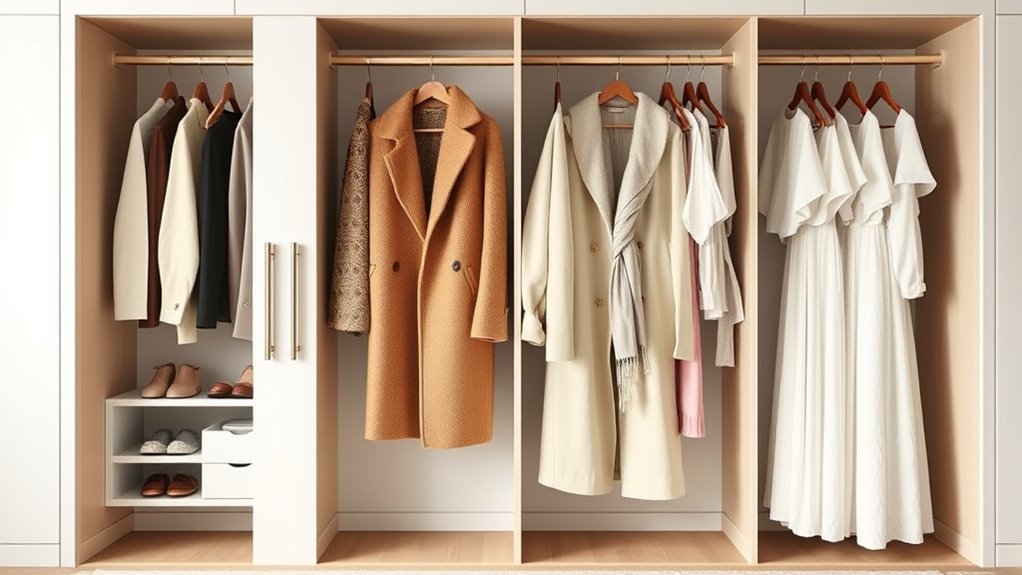
Maintaining a minimalist wardrobe requires intentional effort and consistent habits to prevent clutter from creeping back in. Regular seasonal reviews help you evaluate clothing use and identify items to donate or discard, especially those unused for over a year. To stay on track:
- Conduct seasonal closet reviews at least four times a year, removing unused or worn-out pieces.
- Implement the one-in, one-out rule: for every new item, donate or recycle an existing one.
- Store off-season clothing in labeled bins or vacuum bags to keep your wardrobe organized and space-efficient.
Balancing Style and Functionality in Limited Wardrobes
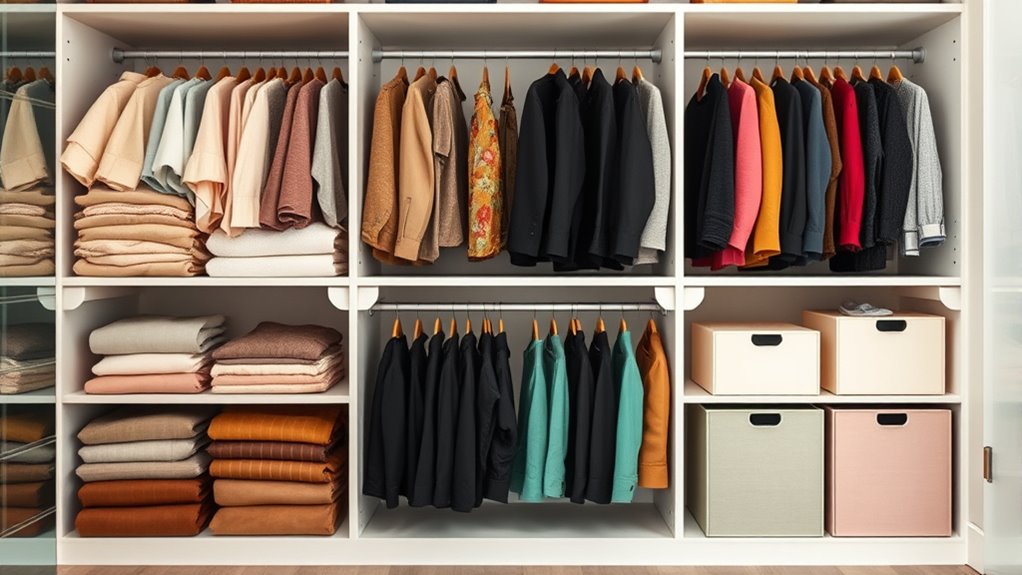
Creating a minimalist wardrobe that balances style and functionality means choosing versatile pieces that serve multiple purposes across different seasons and occasions. Aim for around 74 to 85 items, including workwear, casual, activewear, and outer layers, to cover your needs without excess. Focus on timeless styles and neutral colors that can be easily mixed and matched, supporting a cohesive look year-round. Select fabrics suited for each season—lightweight cotton and linen for summer, wool and cashmere for winter—ensuring comfort and adaptability. Incorporate layering pieces for transitional weather, enhancing versatility without clutter. Prioritize quality over quantity to extend each garment’s lifespan, reduce waste, and lower your environmental impact. A sustainable wardrobe may include around 74 garments and 20 outfits, supporting a more eco-friendly and mindful approach to fashion. A balanced wardrobe simplifies dressing, saves space, and aligns with sustainable living goals.
Leveraging Layering Techniques for Transition Seasons
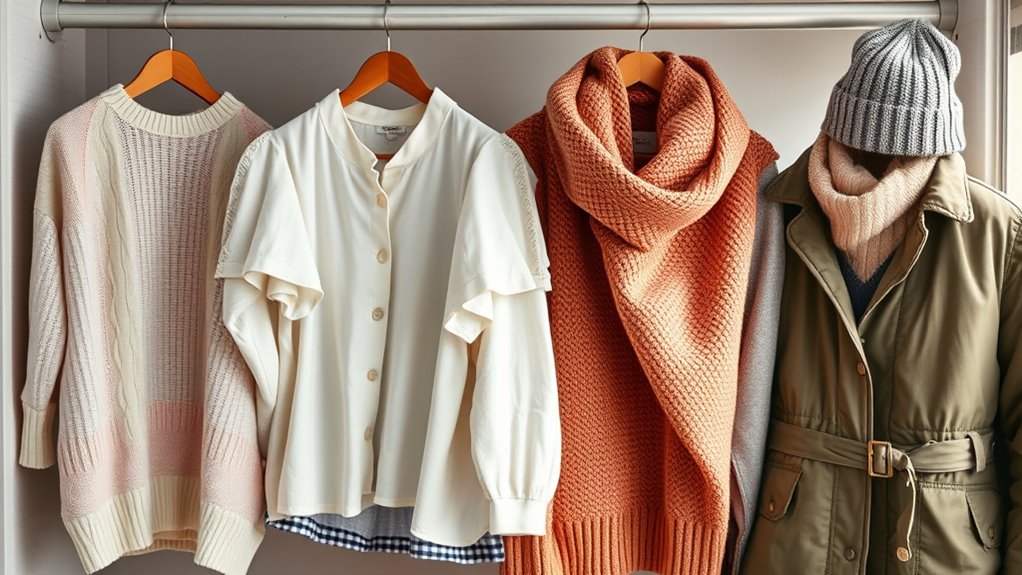
When maneuvering changeover seasons like spring and fall, effective layering is essential to stay comfortable and adaptable to changing weather. You should start with a moisture-wicking base layer to keep you dry. Then, add a mid layer for insulation, such as wool or synthetic fabrics, to trap warmth. Finish with a weather-resistant outer shell to shield against wind, rain, or snow. To optimize your transition wardrobe, consider these tips:
Layer effectively with moisture-wicking bases, insulating mid layers, and weather-resistant shells for seasonal comfort.
- Adjust layers based on activity levels—remove layers during high-intensity movement.
- Select versatile materials like merino wool or breathable synthetics to suit fluctuating temperatures.
- Incorporate lightweight, waterproof outer layers for unpredictable spring and fall weather. Proper layering ensures comfort, safety, and enjoyment during winter adventures. [Layering is essential for outdoor winter activity success.
Cost-Per-Wear Analysis and Investment in Quality Pieces
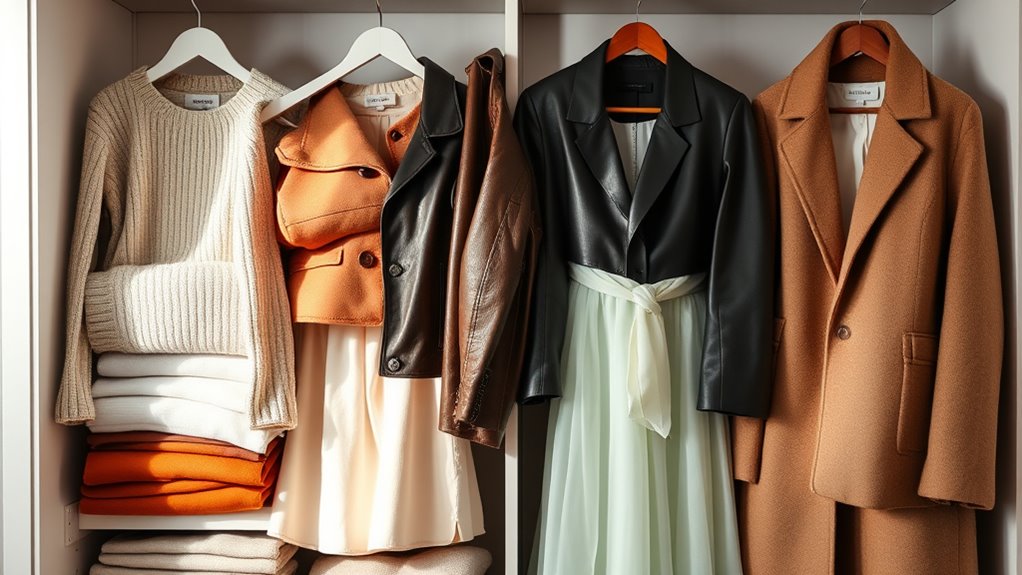
Understanding cost-per-wear (CPW) helps you evaluate the true value of each clothing item by dividing its price by the number of times you wear it. This calculation reveals whether your purchases are worth the investment. Higher-quality pieces, like boutique items, often have a lower CPW because they last longer and withstand repeated wear. For example, a $600 jacket worn 120 times costs just $5 per wear, while a $150 jacket worn 15 times costs $10. Investing in versatile, durable pieces reduces overall CPW and promotes smarter spending.
| Item | Total Cost | Wears | CPW | Emotional Impact |
|---|---|---|---|---|
| Designer coat | $800 | 200 | $4 | Confidence in longevity |
| Fast fashion top | $30 | 2 | $15 | Waste of money, low value |
| Classic trousers | $130 | 104 | $1.25 | Satisfaction from versatility |
| Trendy dress | $70 | 5 | $14 | Short-lived excitement |
| Timeless blazer | $172 | 52 | $3.30 | Feeling stylish daily |
Evidence-Based Recommendations for Sustainable Wardrobe Management
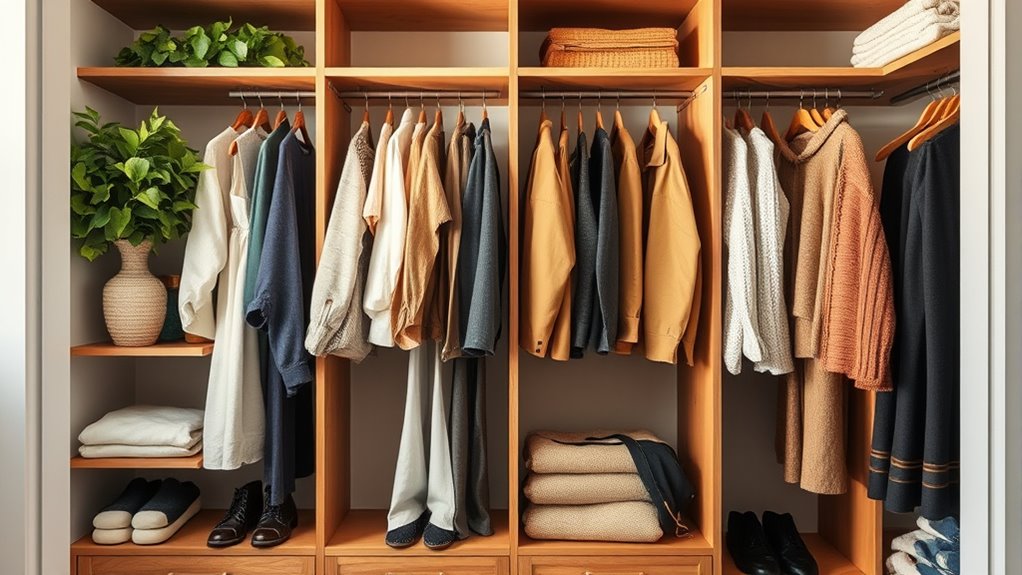
Digital wardrobe management tools, such as apps like SYW, offer practical ways to promote sustainable clothing habits. These apps help you visualize your wardrobe, reduce impulsive purchases, and extend the lifespan of your clothes. By tracking what you own, you become more mindful and make smarter choices. To maximize their benefits, consider these tips:
- Regularly update your digital wardrobe to reflect your current collection.
- Use the app’s insights to identify versatile pieces and plan outfits accordingly.
- Educate yourself on digital literacy to enhance your engagement and sustainability efforts.
- These tools can also help you monitor the eco-friendly materials and ethical brands in your wardrobe, promoting more conscious consumption. Synthetic fibers like polyester, nylon, and acrylic are made from fossil fuels and can take up to a thousand years to biodegrade.
Using these tools encourages you to wear more of what you already own, decreasing waste and overconsumption. With consistent use, you’ll develop habits that support a smaller, more sustainable wardrobe, benefiting both the environment and your budget.
Frequently Asked Questions
How Can I Adapt a Minimal Wardrobe for Unpredictable Weather Changes?
To adapt your minimal wardrobe for unpredictable weather, you should focus on layering versatile, high-quality pieces like lightweight sweaters, jackets, and vests. Choose neutral colors for easy mix-and-match outfits and fabrics that respond well to changing conditions, such as moisture-wicking or wind-resistant materials. Keep off-season clothes stored away, declutter regularly, and select pieces that can be worn alone or layered, ensuring you’re prepared for any weather shifts.
What Are the Best Strategies to Maintain Variety With Limited Pieces?
You might think having limited pieces limits your style, but strategic choices prove otherwise. Focus on versatile, neutral items that can be layered or mixed with accessories. Rotate your wardrobe seasonally and use a modular approach to maximize options. Incorporate a few trendy or colorful pieces to keep looks fresh. By emphasizing quality, fit, and interchangeable pieces, you create a diverse wardrobe that adapts effortlessly to any occasion.
How Often Should I Reassess and Update My Seasonal Wardrobe?
You should reassess and update your seasonal wardrobe about once every 6 to 12 months. Keep an eye on how your clothes fit, wear out, or if your lifestyle changes. With unpredictable weather and fast-changing trends, staying flexible helps. Regularly evaluate your wardrobe to avoid clutter and stay current. This way, you can incorporate new pieces when needed, ensuring your wardrobe remains functional, stylish, and adaptable to your needs.
Which Fabrics Are Most Durable and Sustainable for Year-Round Wear?
When choosing fabrics for year-round wear, durability and sustainability matter most. Hemp stands out because it’s incredibly strong, grows quickly, needs less water and land, and decomposes naturally. Linen is also durable, gets stronger with age, and thrives in poor soil. Tencel offers longevity, eco-friendly manufacturing, and moisture management. Organic and recycled cotton are sustainable options, though recycled cotton may be less durable. Prioritize these fabrics for a resilient, eco-conscious wardrobe.
How Do I Balance Style Trends With Minimalist Principles?
To balance style trends with minimalist principles, you should focus on integrating key trends through high-quality, versatile pieces. Keep your wardrobe rooted in timeless basics, then update outfits with trendy accessories or a statement piece. Mix and match these items for a fresh look without cluttering your closet. Prioritize simplicity, neutral colors, and functionality, so your wardrobe remains streamlined, sustainable, and stylish, adapting easily to evolving fashion trends.
Conclusion
So, you’ve built a 15-item wardrobe that covers all four seasons—proof that less truly is more. Who knew that simplicity could be so versatile and sustainable? Maybe now you’ll finally embrace minimalism instead of drowning in clutter. After all, with carefully chosen pieces, you’ve proven you don’t need endless options to stay stylish year-round—just a smart, evidence-backed approach and a little irony to keep things interesting.
I’m Theodore, and I love tiny houses. In fact, I’m the author of Tiny House 43, a book about tiny houses that are also tree houses. I think they’re magical places where imaginations can run wild and adventures are just waiting to happen.
While tree houses are often associated with childhood, they can be the perfect adult retreat. They offer a cozy space to relax and unwind, surrounded by nature. And since they’re typically built on stilts or raised platforms, they offer stunning views that traditional homes simply can’t match.
If you’re looking for a unique and romantic getaway, a tree house tiny house might just be the perfect option.










